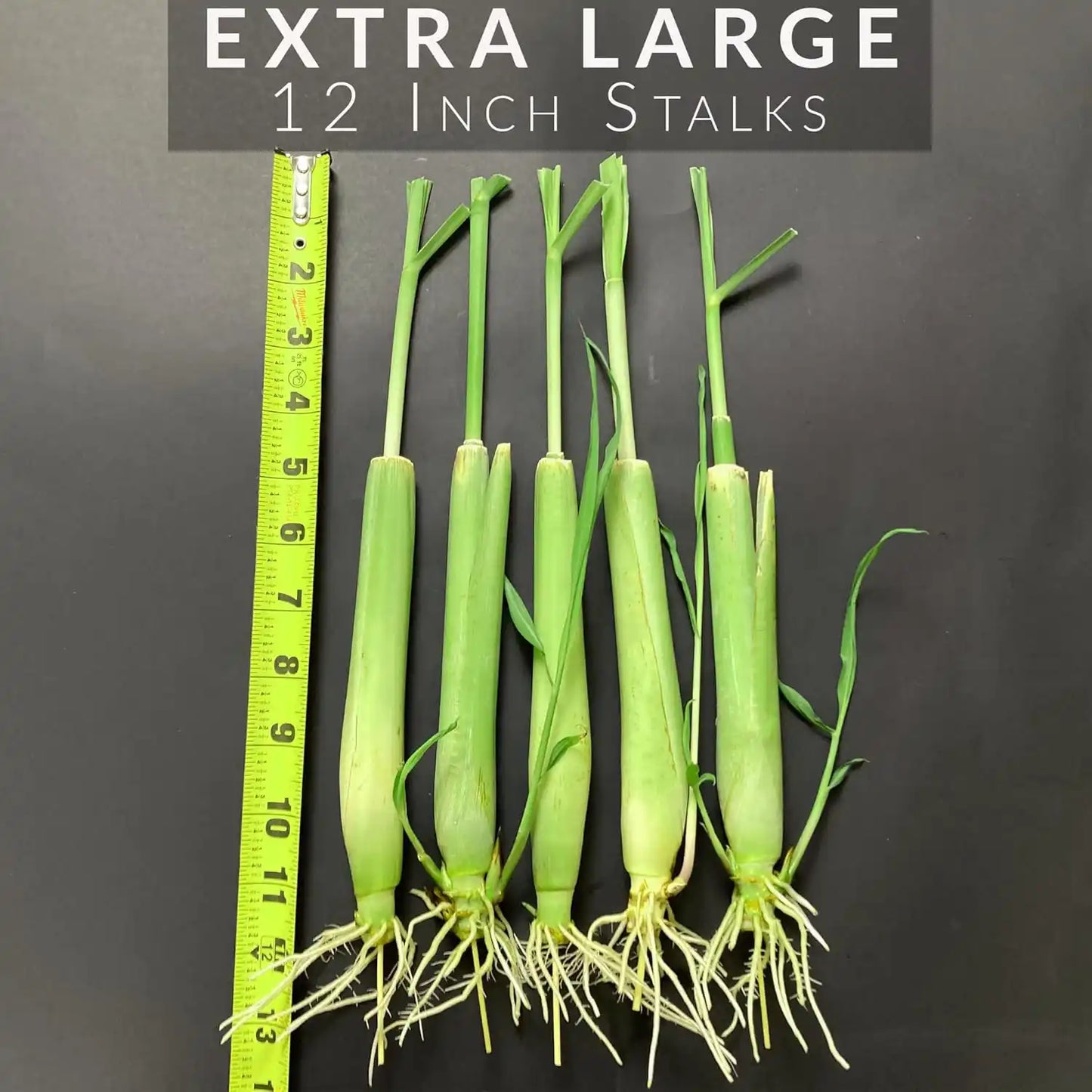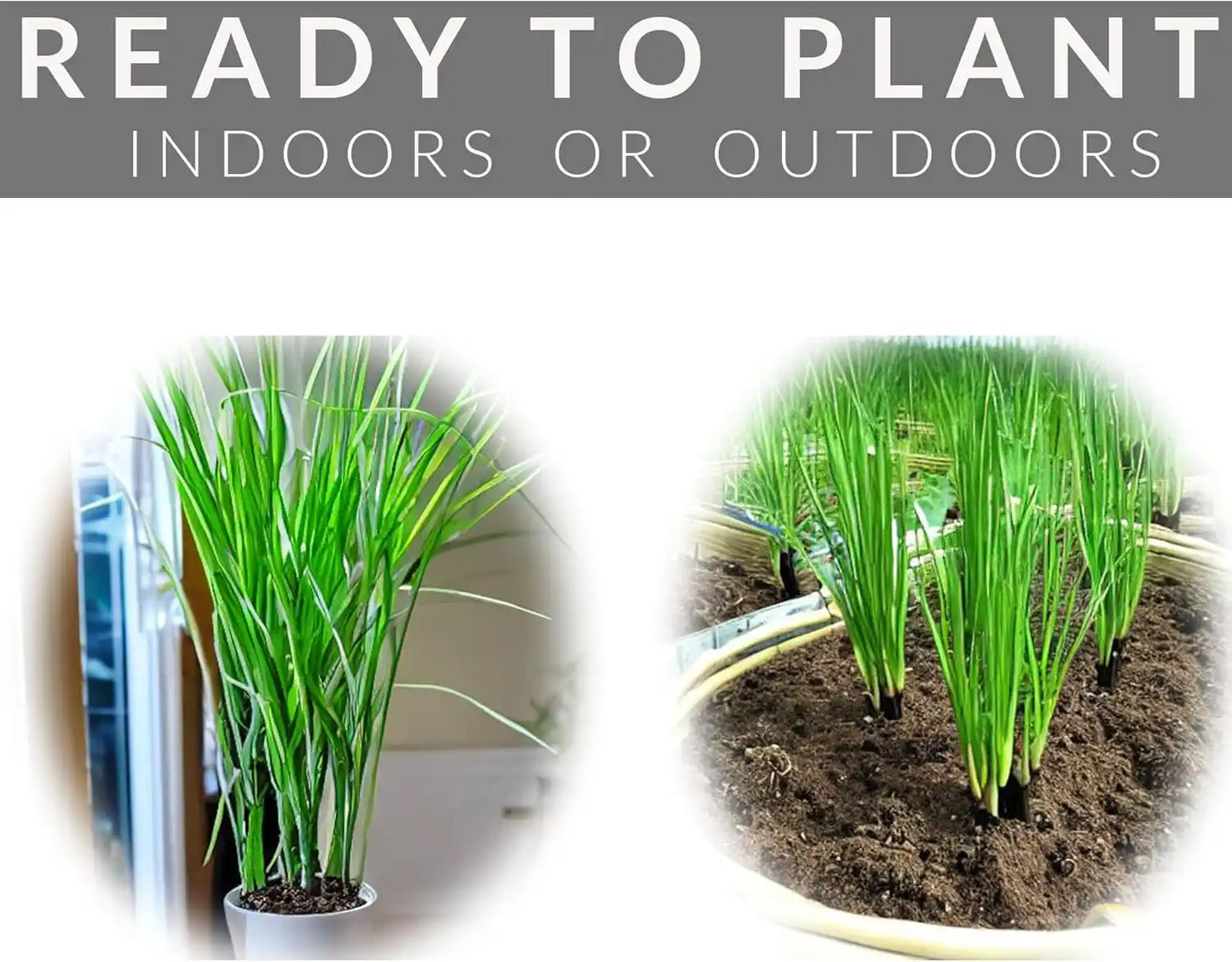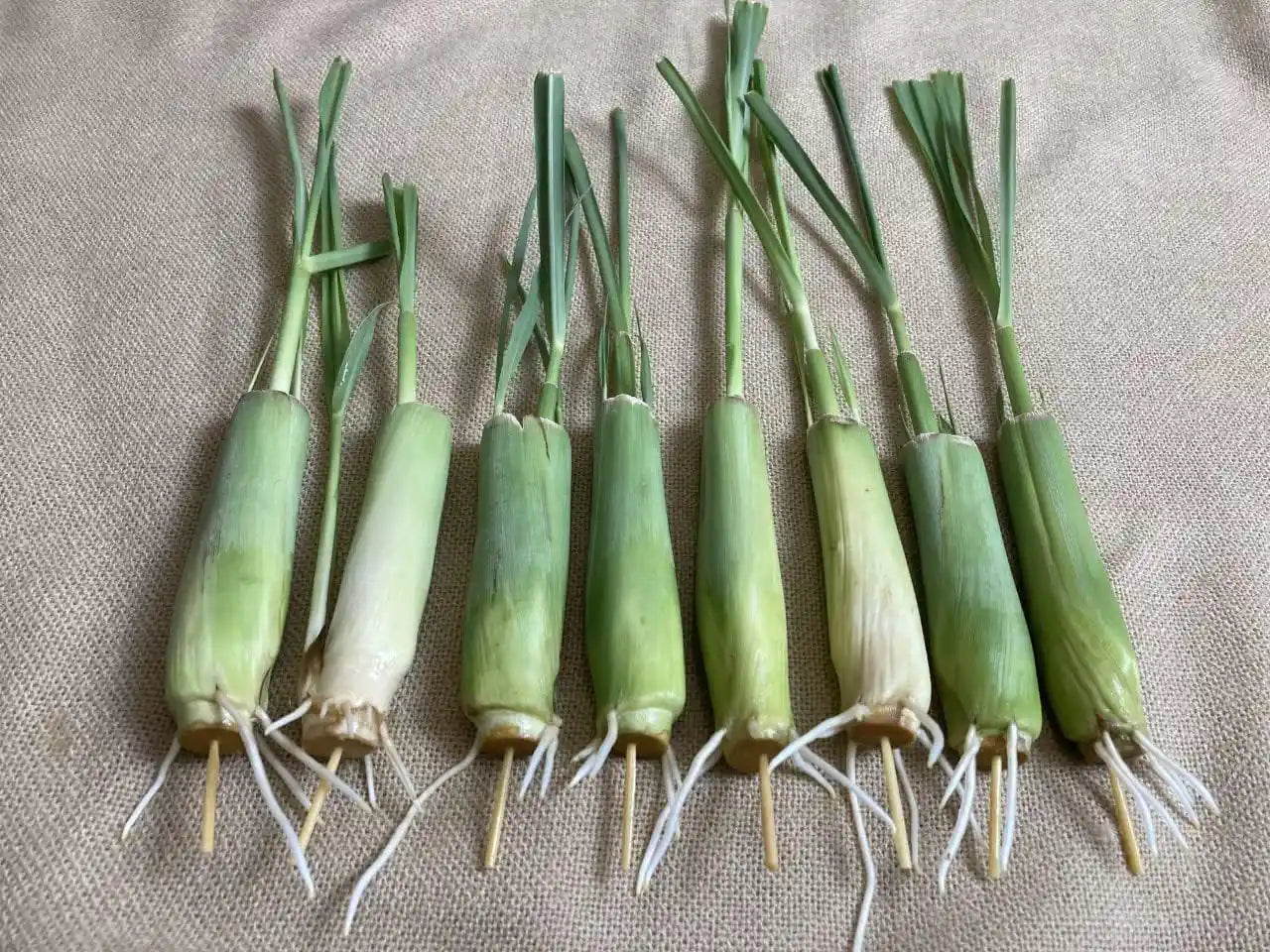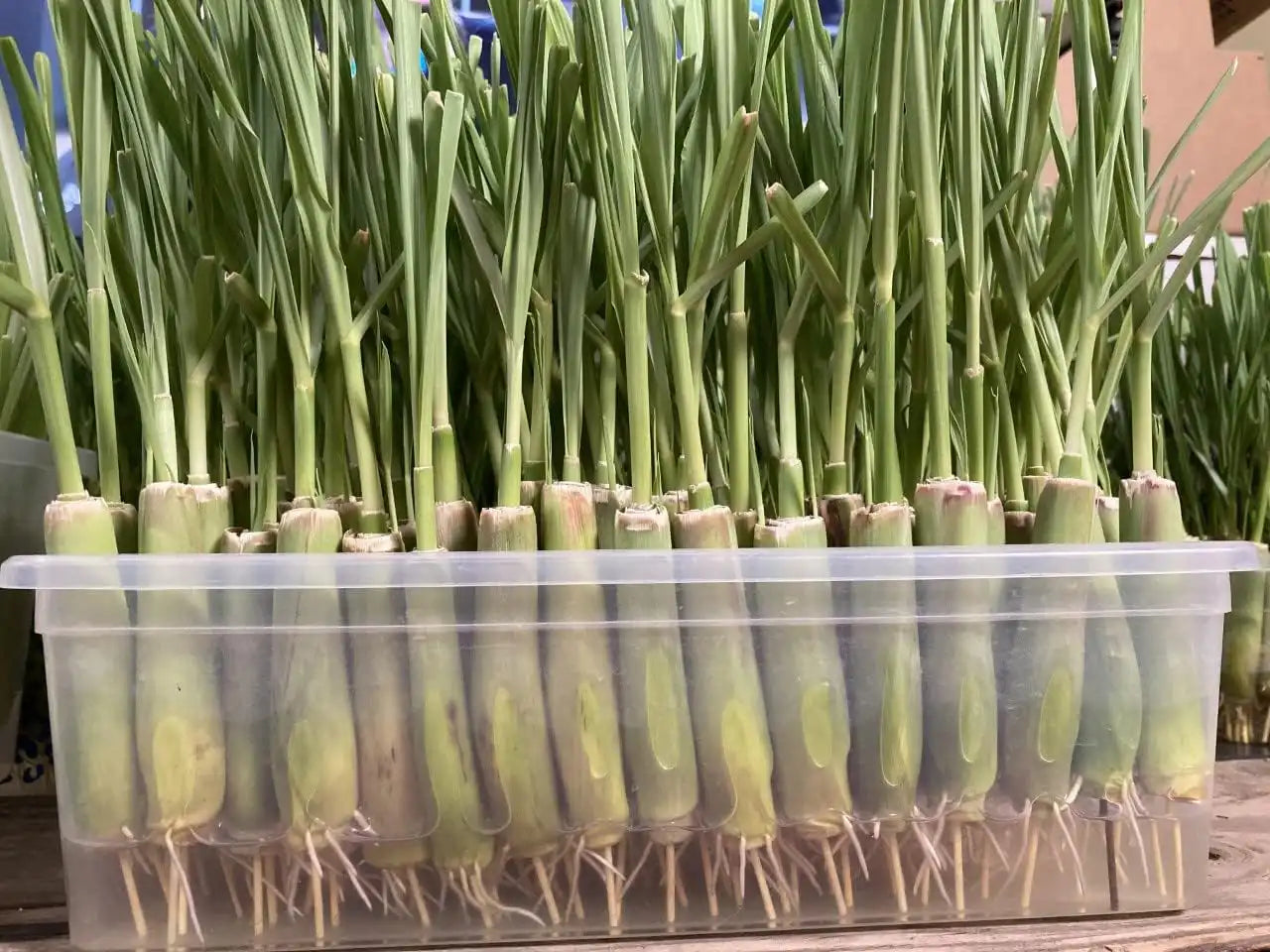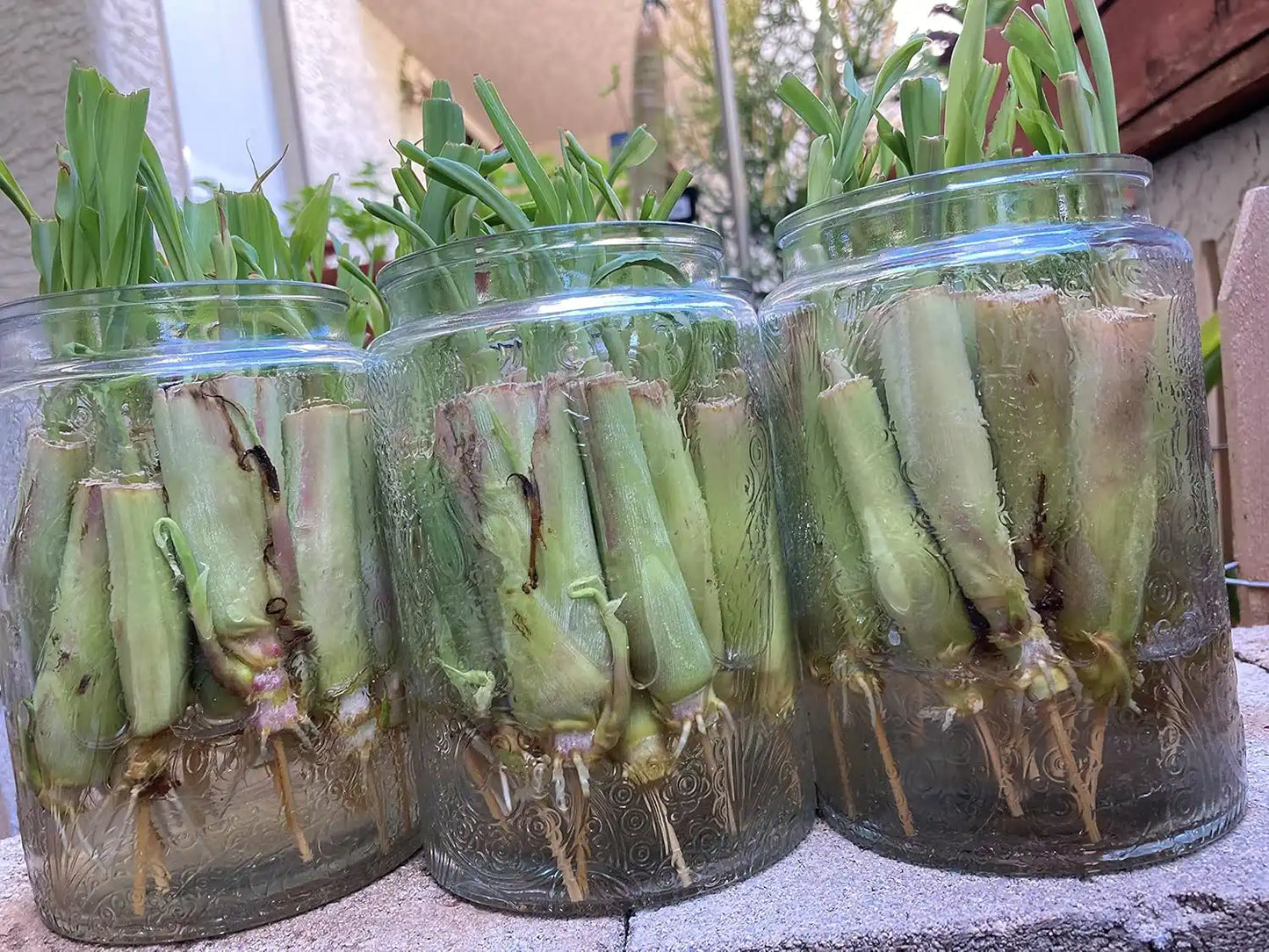The Ultimate Guide to Growing & Using Live Lemongrass Plants
Introduction to Lemongrass Plants: A Versatile and Essential Herb


Lemongrass, known scientifically as Cymbopogon citratus and Cymbopogon flexuosus, is an incredibly versatile and aromatic plant with a wide range of uses in culinary arts, herbal medicine, and natural pest control. This fragrant grass, characterized by its tall, slender stalks and refreshing citrus scent, is a staple in many kitchens around the world, particularly in Thai, Vietnamese, and Indian cuisine. Its bold, lemony flavor enhances everything from soups and curries to teas and marinades, making it a favorite among chefs and home cooks alike.
Beyond its culinary appeal, live lemongrass plants are also highly valued for their medicinal properties. Traditionally used in herbal medicine, lemongrass has been known to aid digestion, reduce inflammation, and promote relaxation. Its essential oils contain powerful compounds such as citral and geraniol, which possess antimicrobial, antifungal, and anti-inflammatory properties. This makes lemongrass essential oil a popular ingredient in natural remedies, skincare products, and aromatherapy.
Additionally, lemon grass plants serve as an effective natural mosquito repellent, making them an excellent choice for those looking to keep their outdoor spaces pest-free without relying on harsh chemicals. Many gardeners and homeowners grow live lemongrass near patios, doorways, and garden beds to deter mosquitoes and other insects naturally. The extracted essential oil can also be used to create homemade bug sprays and air fresheners.
Whether you are interested in growing your own lemongrass, harvesting it for culinary use, extracting its beneficial essential oils, or utilizing it as a natural pest deterrent, this guide will provide everything you need to know. Whether you're a seasoned gardener or just starting out, this comprehensive resource will help you successfully cultivate and maximize the benefits of lemongrass live plants. With the right knowledge and techniques, you can enjoy the many advantages of lemongrass, from its culinary delights to its health-boosting and insect-repelling properties.

The Rich History & Origins of Lemongrass: A Timeless Herbal Treasure
Lemongrass has a deep-rooted history spanning thousands of years, with its origins tracing back to ancient India, China, and Egypt. This aromatic, citrus-scented grass has been highly valued across civilizations for its medicinal, culinary, and aromatic properties, making it one of the most versatile plants in traditional herbal practices.
In ancient India, live lemongrass plants played a crucial role in Ayurvedic medicine, where they were praised for their digestive benefits, stress-relieving properties, and ability to reduce inflammation. The herb was commonly used in teas, tinctures, and medicinal preparations to ease stomach discomfort, support the immune system, and promote overall well-being. Ayurvedic practitioners also used lemongrass essential oil to reduce fever, relieve pain, and soothe respiratory ailments, making it a cornerstone of natural healing.
Meanwhile, in ancient China, lemongrass was incorporated into Traditional Chinese Medicine (TCM), where it was believed to harmonize the body’s energy (Qi), improve circulation, and combat infections. The antibacterial and antifungal properties of lemongrass essential oil made it particularly useful for treating wounds, colds, and digestive issues. It was also burned as incense or brewed into herbal teas to promote relaxation and clear the mind.
In ancient Egypt, lemongrass was treasured not only for its medicinal value but also for its fragrant and preservative qualities. Egyptian royalty and healers used lemongrass-infused oils in beauty treatments, perfumes, and embalming rituals, believing in its power to cleanse, purify, and rejuvenate the body.
As global trade flourished, lemongrass plants spread along ancient trade routes, making their way to Southeast Asia, the Middle East, and Africa. Merchants and healers introduced this remarkable herb to new cultures, where it quickly gained popularity in both cooking and natural medicine. The plant thrived in tropical climates, leading to widespread cultivation in countries such as Thailand, Indonesia, and Malaysia, where it became a key ingredient in local cuisine and herbal remedies.
Today, major producers of lemongrass include Thailand, India, China, and Brazil, where large-scale cultivation supports its use in cooking, herbal medicine, and essential oil production. Lemon grass plants are now grown worldwide, appreciated not only for their bold citrus flavor in dishes but also for their powerful health benefits and ability to repel mosquitoes naturally.
From ancient healing traditions to modern wellness practices, lemongrass live plants continue to be a staple in gardens, kitchens, and apothecaries worldwide, proving that this fragrant herb is truly a timeless treasure.

Where Lemongrass Grows Best: Ideal Conditions for Thriving Plants
Lemongrass live plants flourish in warm, tropical climates, but with the right care, they can also be successfully grown in colder regions. Whether you are planting lemongrass in your garden, in containers, or indoors, understanding its preferred growing conditions will help you cultivate healthy, vibrant plants with fragrant, flavorful stalks.
Ideal Growing Conditions for Lemongrass
1. Climate
Lemongrass thrives in warm, humid environments and is best suited for USDA Hardiness Zones 9-11. These regions provide the ideal conditions for year-round growth, as lemongrass prefers consistently warm temperatures and struggles in frost-prone areas. However, with the right precautions, live lemongrass can also be grown in cooler climates.
2. Temperature Requirements
The optimal temperature range for lemon grass plants is between 70°F - 95°F (21°C - 35°C). Exposure to frost or temperatures below 50°F (10°C) can weaken the plant and cause it to die back. If you live in a colder climate, consider:
- Planting lemongrass in pots that can be moved indoors during winter to protect them from freezing temperatures.
- Using a greenhouse or indoor grow lights to maintain warmth and extend the growing season.
- Applying mulch around the base of outdoor plants to help insulate the roots in cooler months.
3. Sunlight Needs
For lemongrass live plants to grow strong, healthy stalks, they require full sun exposure, receiving at least 6-8 hours of direct sunlight daily. Sunlight is essential for developing the plant’s signature citrus aroma and vibrant green leaves. While lemongrass can tolerate partial shade, it may grow slower and develop weaker stalks in low-light conditions.
4. Soil Preferences
Well-draining soil is key to preventing issues such as root rot, which can quickly harm lemon grass plants. The ideal soil type is sandy loam, which allows for proper drainage while retaining enough moisture to support healthy growth. A pH range of 5.5 - 7.5 is best for lemongrass, ensuring it absorbs nutrients efficiently. If your soil is heavy clay or compacted, consider:
- Amending it with sand or organic compost to improve aeration and drainage.
- Using raised beds or containers for better soil control.
5. Watering & Humidity
Lemongrass requires consistent moisture to thrive, but it is equally important to avoid overwatering. The plant prefers moderate to high humidity, which mimics its tropical native environment. To maintain the right moisture levels:
- Water deeply but allow the topsoil to dry slightly between waterings to prevent soggy conditions.
- Ensure good drainage in pots and garden beds to prevent stagnant water.
- Mist indoor plants occasionally if the air is dry, especially during winter months.
Growing Lemongrass in Colder Climates
If you live in a cooler region, you can still enjoy the benefits of live lemongrass plants by growing them in containers. This allows you to:
- Move them indoors when temperatures drop, ensuring they survive winter.
- Use a greenhouse or indoor grow setup to cultivate lemongrass year-round.
- Extend the growing season by keeping plants protected from frost and sudden cold snaps.
By following these optimal growing conditions, you can cultivate healthy, vigorous lemon grass plants that provide flavorful stalks, medicinal benefits, and natural mosquito-repelling properties—no matter where you live!
Essential Care for Lemongrass: Soil, Sun, Water, and Fertilization
Growing healthy, vibrant lemongrass live plants requires the right balance of nutrient-rich soil, full sun exposure, consistent watering, and proper fertilization. When these key factors are optimized, lemon grass plants grow faster, develop strong aromatic stalks, and thrive in a variety of conditions. Whether you're growing lemongrass outdoors in a garden, in raised beds, or indoors in containers, understanding its essential care needs will ensure successful cultivation.
Soil Requirements: Creating the Perfect Growing Medium
For lemongrass plants to thrive, they need well-draining, sandy loam soil that retains moisture without becoming waterlogged. Proper soil composition is crucial to prevent root rot, which can quickly damage the plant. The best soil for lemongrass live plants should:
✅ Be rich in organic matter to provide essential nutrients.
✅ Have a light, airy texture to encourage strong root development.
✅ Have a pH level between 5.5 and 7.5, meaning it should be slightly acidic to neutral.
If your garden soil is heavy clay, it can trap water and suffocate roots, leading to poor growth. To improve drainage and aeration, mix in:
- Sand to increase porosity.
- Compost or aged manure to enhance fertility.
- Perlite or pumice to prevent soil compaction.
Adding mulch around the base of lemon grass plants is also beneficial. Mulching helps:
- Retain soil moisture during hot weather.
- Regulate soil temperature, keeping roots protected.
- Reduce weed growth, preventing competition for nutrients.
By ensuring proper soil conditions, your lemongrass live plants will establish deep, strong roots and produce healthy, flavorful stalks for cooking and herbal use.
Sunlight Needs: Maximizing Growth & Aroma
Lemongrass is a sun-loving herb that requires at least 6-8 hours of direct sunlight daily for optimal growth. The more sun exposure lemon grass plants receive, the stronger their citrusy fragrance and essential oil content will be.
Key Sunlight Tips:
✅ Place lemongrass live plants in a south-facing location for maximum sun exposure.
✅ If growing indoors, position pots near a bright window or use grow lights to supplement natural light.
✅ In regions with intense summer heat, provide partial afternoon shade to prevent scorching.
When growing lemongrass indoors, using full-spectrum LED grow lights can mimic natural sunlight, ensuring steady growth throughout the year. Without adequate light, lemongrass will grow weak, spindly stalks instead of thick, lush ones.

Watering: Keeping Lemongrass Hydrated Without Overwatering
Proper watering is essential to maintaining healthy, live lemongrass plants. Since lemongrass thrives in moist conditions, it requires regular watering, especially in hot climates. However, too much water can lead to root rot, while too little can cause dry, brittle stalks.
Watering Guidelines for Lemongrass:
✅ Hot Weather: Water every 2-3 days to keep the soil evenly moist.
✅ Cooler Months: Water once a week to prevent over-saturation.
✅ Signs of Underwatering: Leaves begin to curl, dry out, or turn brown—increase watering frequency.
✅ Signs of Overwatering: Yellowing leaves, soggy soil, or mushy roots—reduce watering and improve drainage.
Using rainwater or filtered water is recommended because tap water often contains minerals and salts that can build up in the soil, potentially harming the plant over time. If possible, collect rainwater for a more natural watering approach.
Fertilizing Lemongrass: Boosting Growth & Flavor
Lemongrass is a nutrient-hungry plant, meaning it requires regular fertilization to maintain lush, green growth and robust flavor. Whether you're growing lemongrass live plants in a garden or containers, proper feeding ensures vigorous stalk development and strong essential oil production.
✅ Organic Fertilization:
- Compost or aged manure provides a slow-release source of nutrients.
- Fish emulsion or seaweed extract is ideal for promoting leafy growth.
- Liquid kelp fertilizers help strengthen plants and boost essential oil concentration.
✅ Synthetic Fertilization:
- A balanced 10-10-10 fertilizer supports steady growth.
- A nitrogen-rich formula (e.g., 20-10-10) enhances leaf production and deep green color.
✅ Feeding Schedule:
- Spring to Late Summer (Peak Growing Season): Fertilize every 2-3 weeks for vigorous growth.
- Fall and Winter (Dormant Season): Reduce feeding to once a month or stop entirely when growth slows.
Over-fertilizing can lead to excessive leaf growth with weak stalks, so it's important to strike the right balance.
Final Tips for Growing Strong & Healthy Lemongrass
✅ Choose the right soil: Well-draining, nutrient-rich, and slightly acidic to neutral pH (5.5-7.5).
✅ Provide full sun: 6-8 hours of daily sunlight for optimal aroma and growth.
✅ Water consistently: Moist soil without waterlogging—adjust based on climate conditions.
✅ Fertilize regularly: Use organic compost or nitrogen-rich fertilizer for healthy development.
By following these guidelines, you’ll be able to grow strong, vibrant lemon grass plants that provide fresh, flavorful stalks for cooking, medicinal use, and natural pest control. Whether you're cultivating lemongrass live plants outdoors or indoors, giving them the proper soil, sun, water, and nutrients will ensure a bountiful, aromatic harvest year-round!

Harvesting & Storing Lemongrass
When to Harvest Lemongrass
Lemongrass is typically ready for harvest 4-6 months after planting, once the stalks reach a height of 12-18 inches and develop a thick, sturdy base. Fully matured stalks provide the best flavor and aroma, making them ideal for culinary use, herbal teas, and essential oil extraction. While younger, thinner stalks can still be used, they tend to be less aromatic and may lack the robust citrusy punch that lemongrass live plants are known for.
To harvest, use a sharp knife or garden shears to cut stalks at the base of the plant, leaving at least one inch above the ground to encourage regrowth. If you’re gathering leaves for teas or other uses, trim the long, slender blades with scissors, ensuring not to remove too much foliage at once, as this can stress the plant and slow future growth.
How to Harvest Correctly
When harvesting, always select the outer stalks first, as new growth emerges from the center of the plant. This method helps maintain a healthy, productive plant and ensures a continuous supply of fresh lemon grass plants.
For optimal regrowth, cut stalks as close to the base as possible while keeping the root system intact. This allows the plant to remain strong and continue producing new stalks for months, even years, with proper care. Harvesting every 3-4 weeks encourages vigorous growth and ensures a steady supply of fresh lemongrass throughout the season.
Storing Fresh Lemongrass
Freshly harvested lemongrass live stalks can be stored using several methods to retain their flavor and aroma for extended periods.
- Refrigeration: Wrap fresh stalks in a damp paper towel and place them inside a plastic bag or airtight container in the refrigerator. This method keeps lemongrass fresh for up to 3 weeks.
- Freezing: Chop stalks into smaller pieces and store them in airtight containers or freezer bags. Frozen lemongrass can last up to 6 months and can be used directly from the freezer without thawing, making it perfect for soups, stews, and curries.
Drying Lemongrass for Long-Term Storage
Drying lemongrass live stalks is an excellent way to preserve their citrusy aroma for tea blends, spice mixes, or homemade essential oils.
- Air Drying: Bundle fresh stalks together and hang them upside down in a cool, dry, and well-ventilated area until they become crisp and brittle.
- Using a Dehydrator: Set the dehydrator to 95-115°F (35-46°C) and allow lemongrass stalks to dry for 8-12 hours until fully dehydrated.
- Storage: Once dried, store lemongrass in an airtight glass jar, away from moisture, heat, and direct sunlight to maintain its potency.
Lemongrass Paste for Easy Use
For convenience, blend fresh lemongrass stalks with a small amount of water or oil to create a flavor-packed paste. Pour the paste into ice cube trays and freeze it, allowing for easy portioning whenever needed for cooking.
Preserving Lemongrass for Extended Use
If you want to keep your lemongrass live plant harvest fresh for even longer, try these creative preservation techniques:
- Infused Lemongrass Oil: Chop fresh stalks and submerge them in a carrier oil such as olive or coconut oil for 2-3 weeks. Once infused, strain the oil and store it in a glass bottle for use in cooking, skincare, or aromatherapy.
- Lemongrass Powder: Fully dry lemongrass stalks, then grind them into a fine powder using a spice grinder. Store in an airtight container and use it in spice blends, curries, and herbal teas.
- Pickled Lemongrass: Slice fresh stalks and submerge them in a mixture of vinegar, salt, and sugar. This creates a tangy, preserved lemongrass that can be used in sauces, marinades, or stir-fries.
Using the right harvesting and storage techniques, you can enjoy the bold citrus aroma and health benefits of lemongrass year-round. Whether refrigerated, dried, frozen, or preserved, lemongrass remains a powerhouse ingredient that enhances culinary dishes, herbal remedies, and natural insect repellents for months to come!

How to Use Lemongrass: A Versatile Ingredient for Culinary Creations
Lemongrass is a powerful, aromatic herb that brings a bright citrus flavor to a variety of dishes, making it a staple in Thai, Vietnamese, and Indian cuisine. Whether used in a stew, soups, curries, stir-fries, marinades, or beverages, this fragrant herb enhances flavors with its refreshing lemony essence. Its ability to blend well with spices, coconut milk, and fresh herbs makes it a must-have for both home cooks and professional chefs.
Culinary Uses of Lemongrass
- Curries, Soups, and Stews: One of the most well-known uses of lemongrass live stalks is in rich, flavorful broths and stews. It is a key ingredient in dishes like Thai Tom Yum soup, Vietnamese Pho, and Indian coconut curries, where it adds a zesty, citrusy depth. The stalks are often bruised or lightly crushed before being simmered to release their essential oils, infusing the dish with their distinctive aroma.
- Stir-Fries, Salads, and Sauces: Fresh lemongrass stalks can be finely chopped or ground into a paste to add a burst of citrusy flavor to stir-fries, marinades, and dipping sauces. It pairs well with garlic, ginger, chili, and soy sauce, making it perfect for seasoning meats, tofu, or vegetables. Finely minced lemongrass can also be sprinkled over salads for an added layer of brightness and aroma.
- Infused in Coconut Milk for Rich Marinades: Many Southeast Asian dishes rely on coconut milk infused with lemongrass to create deep, complex flavors. By gently simmering lemongrass stalks in coconut milk, the resulting base becomes an aromatic foundation for curries, marinades, and grilled meats.
- Homemade Broths and Soups: Adding lemon grass plants to homemade broths enhances the freshness and complexity of the soup. The stalks are often tied together in a bouquet garni and simmered with chicken, beef, or vegetable stock to create a delicately citrus-infused broth. The subtle lemony notes work exceptionally well with seafood-based soups as well.
- Refreshing Beverages & Infusions: Lemongrass live stalks are often used in homemade teas, syrups, and cocktails for a citrus twist. It can be steeped in hot water for a calming herbal tea or blended with ginger and honey for an immune-boosting drink. Additionally, lemongrass-infused syrups make a fantastic base for cocktails, lemonades, and iced teas, offering a uniquely refreshing, zesty touch.
From hearty soups to zesty marinades and refreshing drinks, lemon grass plants offer an endless variety of ways to elevate cooking and beverage crafting. Whether you’re using fresh, dried, or frozen lemongrass, incorporating it into your dishes will bring vibrancy, depth, and a signature citrusy aroma to every meal!

How to Make Lemongrass Tea: A Refreshing & Health-Boosting Drink
Lemongrass tea is a delightfully refreshing and aromatic beverage packed with natural health benefits. Known for its soothing citrus flavor, this tea is often enjoyed as a relaxing herbal remedy that supports digestion, boosts immunity, and promotes overall well-being. Whether served hot or iced, this lemongrass tea is an excellent way to enjoy the flavors and benefits of live lemongrass plants.
Step-by-Step Guide to Making Fresh Lemongrass Tea
1. Prepare the Lemongrass Stalks
Chop fresh lemon grass plants into small pieces, ensuring to include both the bulbous base and the tender green leaves. Chopping or lightly bruising the stalks helps release the essential oils, which enhances the tea’s citrusy aroma and flavor.
2. Boil in Water to Extract Flavor
Add the chopped lemongrass stalks to 2 cups of water and bring it to a gentle boil. Allow it to simmer for 5-10 minutes, depending on how strong you want the flavor to be. The longer the tea simmers, the more intense the citrusy notes will become.
3. Enhance the Flavor with Natural Additives
For additional depth and health benefits, try adding:
- Honey for natural sweetness.
- Ginger for a warming, slightly spicy kick.
- Lemon zest to amplify the citrus flavor.
4. Strain and Serve
Once the tea is brewed, strain out the lemongrass pieces and pour the liquid into a cup. It can be enjoyed hot for a soothing herbal drink or poured over ice for a cool, revitalizing iced tea.
5. Mix with Other Herbs for Extra Benefits
For a more complex herbal blend, mix lemongrass tea with:
- Mint for a cooling effect and digestion support.
- Chamomile for relaxation and better sleep.
- Lemon balm for an additional citrus boost and stress relief.
Whether you're sipping it warm on a chilly day or enjoying it iced as a summer refreshment, lemongrass tea is a versatile, health-boosting beverage that brings out the best of live lemongrass plants in an easy, enjoyable way!

Lemongrass for Aromatherapy and Wellness: A Natural Path to Relaxation
Lemongrass is not just a culinary powerhouse; it is also a powerful tool in aromatherapy and wellness. With its uplifting citrus scent and naturally soothing properties, lemongrass essential oil is widely used to reduce stress, relieve muscle tension, and promote relaxation. Whether inhaled, applied topically, or added to a bath, live lemongrass plants offer a variety of wellness benefits that enhance both the body and mind.
1. Steam Inhalation for Sinus Relief & Relaxation
Lemongrass is excellent for clearing sinuses and easing congestion. The essential oils in lemon grass plants contain antibacterial and anti-inflammatory properties that help open airways and support respiratory health.
How to Use:
- Boil a pot of water and add a few chopped fresh lemongrass stalks or a few drops of lemongrass essential oil.
- Lean over the pot, cover your head with a towel, and inhale the steam deeply for 5-10 minutes.
- This method helps clear nasal passages, soothe headaches, and promote relaxation.
2. Lemongrass-Infused Bath for a Therapeutic Soak
A lemongrass bath is a wonderful way to relieve stress, ease muscle tension, and rejuvenate the body. The natural compounds in lemongrass help reduce inflammation and promote circulation, making it ideal for relaxation and recovery.
How to Use:
- Add a handful of fresh or dried lemongrass leaves to your bathwater.
- Alternatively, mix a few drops of lemongrass essential oil with a carrier oil like coconut or jojoba oil before adding it to the bath.
- Soak for at least 20 minutes to allow the aromatic properties to relax the body and mind.
3. Massage Oil for Muscle Pain & Tension Relief
Lemongrass is known for its anti-inflammatory and pain-relieving effects, making it an excellent addition to massage oils. It helps relieve muscle stiffness, improve circulation, and ease joint pain.
How to Use:
- Mix 5-6 drops of lemongrass essential oil with a carrier oil (such as coconut or almond oil).
- Gently massage into sore muscles or joints to experience deep relaxation and relief from tension.
- Use after exercise or at the end of a long day for instant soothing effects.
4. Diffusing Lemongrass for a Calming, Stress-Free Atmosphere
Lemongrass is widely used in diffusers to create a refreshing and calming environment. The bright citrus scent naturally uplifts mood, reduces stress, and purifies the air, making it a great addition to homes, offices, or meditation spaces.
How to Use:
- Add 5-10 drops of lemongrass essential oil to a diffuser and let the fragrance fill the room.
- It pairs well with lavender, eucalyptus, or peppermint essential oils for a soothing and invigorating blend.
- Diffusing lemongrass live extracts in the evening can help promote restful sleep and mental clarity.
Lemongrass is a powerful natural remedy that enhances wellness and relaxation in many ways. Whether used for steam inhalation, therapeutic baths, soothing massages, or aromatherapy diffusion, lemon grass plants provide calming, healing, and revitalizing benefits that support both physical and mental well-being.

DIY Lemongrass-Infused Oil for Cooking and Skincare: A Natural Multi-Purpose Elixir
Lemongrass-infused oil is a versatile, fragrant, and nutrient-rich addition to both cooking and skincare routines. By infusing live lemongrass plants in a high-quality carrier oil, you can create a homemade, chemical-free oil that enhances flavor in dishes while also providing hydration and nourishment for the skin. Whether you’re looking to elevate your culinary creations or craft an all-natural beauty product, this DIY infusion is a simple and effective way to harness the benefits of lemon grass plants.
Step-by-Step Guide to Making Lemongrass-Infused Oil
1. Prepare the Lemongrass
Chop fresh lemongrass stalks into small pieces, focusing on the bulbous base and lower stalks, where the essential oils and flavor compounds are most concentrated. Cutting the lemongrass into smaller sections helps to release more aroma and beneficial properties into the oil.
2. Choose a Carrier Oil & Fill the Jar
Select a neutral, high-quality carrier oil that complements both culinary and skincare applications. Some great options include:
- Olive oil – Ideal for cooking and skin nourishment.
- Coconut oil – Great for moisturizing skin and enhancing flavors in tropical dishes.
- Jojoba or sweet almond oil – Best suited for skincare applications due to their lightweight, hydrating properties.
Place the chopped lemongrass live stalks in a clean, dry glass jar and completely submerge them in the chosen oil.
3. Infuse the Oil in a Warm, Sunny Spot
Seal the jar and let the lemongrass-infused oil sit in a warm, sunlit area for two weeks. This gentle, natural infusion process allows the oil to extract the beneficial compounds from the lemon grass plants, creating a deeply aromatic and flavorful oil. Shake the jar every few days to ensure even infusion.
4. Strain & Store Properly
After two weeks, strain the lemongrass-infused oil through a fine mesh strainer or cheesecloth to remove any plant material. Pour the infused oil into a dark glass bottle to preserve its potency and freshness. Storing the oil in a cool, dark place helps prevent oxidation and ensures longer shelf life.
Ways to Use Lemongrass-Infused Oil
✅ For Cooking: Use in stir-fries, salad dressings, soups, or marinades to add a zesty citrus flavor. It’s perfect for enhancing Thai, Vietnamese, and Indian dishes with a rich, aromatic depth.
✅ For Skin Hydration: Apply a small amount to dry skin, cuticles, or lips for deep hydration and nourishment. The antioxidant and antimicrobial properties of lemongrass live extracts make this oil great for soothing irritated skin.
✅ For Natural Remedies: Use as a massage oil to relieve muscle tension, or mix with essential oils like lavender or eucalyptus for a relaxing aromatherapy treatment.
This DIY lemongrass-infused oil is a simple yet powerful way to enjoy the benefits of live lemongrass plants in both the kitchen and skincare routine, offering a natural, chemical-free alternative to store-bought products!
Final Thoughts: Start Growing Your Own Fresh Lemongrass Today!
Lemongrass is one of the easiest and most rewarding plants to grow, offering incredible versatility, low maintenance, and numerous benefits for home gardeners, herbal enthusiasts, and culinary lovers alike. Whether you're cultivating it for its bold citrus flavor, medicinal properties, natural mosquito-repelling abilities, or essential oil extraction, live lemongrass plants are a must-have addition to any garden, patio, or indoor space.
If you're new to growing lemon grass plants or want a simple, hassle-free way to get started, our 8-pack of 6-inch lemongrass stalks is the perfect beginner-friendly option. These fast-growing stalks root quickly, allowing you to establish a thriving lemongrass patch with ease. Ideal for herb gardens, kitchen planters, and DIY projects, this pack provides an affordable and effective way to enjoy fresh, homegrown lemongrass year-round.
For those looking for larger, more established plants with an immediate visual impact, our 5-pack of 12-inch premium rooted lemongrass plants is the ultimate choice. These strong, robust plants are ready to be transplanted directly into your garden beds, patio planters, or indoor pots, ensuring instant greenery and faster harvests. Their deep root system makes them a hardy, long-term addition to your space, offering a continuous supply of flavorful stalks for cooking, herbal teas, and homemade remedies.
No matter which option you choose, lemongrass live plants will continue to multiply and flourish, giving you a never-ending source of fresh, homegrown lemongrass. Don’t miss out—order now and start growing your own fragrant, flavorful lemongrass today!
Thaiphoon Jira
5 Live Lemongrass Plants - 12 Inch Rooted Stalks, Ready to Plant
Share
Thaiphoon Jira





